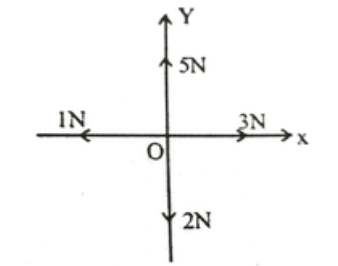The force on a charged particle due to electric and magnetic fields is given by →F=q→E+q→vX→B. Suppose →E is along the X-axis and →B along the Y-axis. In what direction and with what minimum speed v should a positively charged particle be sent so that the net force on it is zero?
The correct Answer is:A, B, D
To solve the problem, we need to find the direction and minimum speed v of a positively charged particle such that the net force on it due to electric and magnetic fields is zero. The force on the charged particle is given by:
→F=q→E+q→v×→B
Step 1: Understand the Direction of Fields
Given:
- The electric field →E is along the X-axis.
- The magnetic field →B is along the Y-axis.
We can represent these fields as:
→E=E^i
→B=B^j
Step 2: Set Up the Force Equation
For the net force to be zero, we have:
→F=0⟹q→E+q→v×→B=0
This simplifies to:
→E=−→v×→B
Step 3: Express the Velocity Vector
Let the velocity vector →v be expressed in terms of its components:
→v=vx^i+vy^j+vz^k
Step 4: Calculate the Cross Product
Now we compute →v×→B:
→v×→B=(vx^i+vy^j+vz^k)×(B^j)
Using the right-hand rule and properties of cross products, we find:
→v×→B=vxB^k−vyB^i
Step 5: Set Up the Equation
Substituting this into our earlier equation gives:
→E=−(vxB^k−vyB^i)
This leads to:
→E=vyB^i−vxB^k
Step 6: Compare Components
Now we can compare components from both sides:
1. The ^i component gives:
E=vyB
2. The ^k component gives:
0=−vxB⟹vx=0
Step 7: Solve for vy and vz
Since vx=0, we can substitute this back into the equation for E:
E=vyB
From this, we can express vy:
vy=EB
Step 8: Determine the Direction and Minimum Speed
Since vx=0 and vy=EB, the velocity vector can be expressed as:
→v=0^i+EB^j+vz^k
To ensure the net force is zero, we need to have a component along the z-axis:
vz=EB
Final Result
The minimum speed v of the charged particle should be:
v=√v2y+v2z=√(EB)2+(EB)2=EB√2
The direction of the velocity vector is in the z-direction.
Given:
- The electric field →E is along the X-axis.
- The magnetic field →B is along the Y-axis.
→E=E^i
→B=B^j
For the net force to be zero, we have:
→F=0⟹q→E+q→v×→B=0
This simplifies to:
→E=−→v×→B
Let the velocity vector →v be expressed in terms of its components:
→v=vx^i+vy^j+vz^k
Now we compute →v×→B:
→v×→B=(vx^i+vy^j+vz^k)×(B^j)
Using the right-hand rule and properties of cross products, we find:
→v×→B=vxB^k−vyB^i
Substituting this into our earlier equation gives:
→E=−(vxB^k−vyB^i)
This leads to:
→E=vyB^i−vxB^k
Now we can compare components from both sides:
1. The ^i component gives:
E=vyB
2. The ^k component gives:
0=−vxB⟹vx=0
Since vx=0, we can substitute this back into the equation for E:
E=vyB
From this, we can express vy:
vy=EB
Since vx=0 and vy=EB, the velocity vector can be expressed as:
→v=0^i+EB^j+vz^k
To ensure the net force is zero, we need to have a component along the z-axis:
vz=EB
The minimum speed v of the charged particle should be:
v=√v2y+v2z=√(EB)2+(EB)2=EB√2
The direction of the velocity vector is in the z-direction.
Topper's Solved these Questions
- BOOK - HC VERMA ENGLISHCHAPTER - PHYSICS AND MATHEMATICSEXERCISE - Question for short Answer14videos
PHYSICS AND MATHEMATICS
- BOOK - HC VERMA ENGLISHCHAPTER - PHYSICS AND MATHEMATICSEXERCISE - Objective 25videos
PHYSICS AND MATHEMATICS
- BOOK - HC VERMA ENGLISHCHAPTER - NEWTON'S LAWS OF MOTIONEXERCISE - Questions for short Answer17videos
NEWTON'S LAWS OF MOTION
- BOOK - HC VERMA ENGLISHCHAPTER - REST AND MOTION : KINEMATICSEXERCISE - Question for short Answer13videos
REST AND MOTION : KINEMATICS
Similar Questions
A charged particle is moved along a magnetic field line. The magnetic force on the particle is
View SolutionThe force →F experienced by a particle of charge q moving with a velocity →v in a magnetic field →B is given by →F=q(→v×→B). Which pairs of vectors are at right angles to each other?
View SolutionThe force →F experienced by a particle of charge q moving with a velocity →v in a magnetic field →B is given by →F=q(→v×→B). Which pairs of vectors are at right angles to each other?
View SolutionA particle is moving with constant speed v along x - axis in positive direction. Find the angular velocity of the particle about the point (0, b), when position of the particle is (a, 0).
View SolutionAn electron is moving along positive x-axis A unifrom electric field exists towards negative y-axis. What should be the direction of magnetic field of suitable magnitude so that net force of electrons is zero .
View SolutionAn electron beam projected along + X-axis, experience a force due to a magnetic field along the + Y-axis. What is the direction of the magnetic field?
View SolutionPositively charged particles are projected into a magnetic field. If the direction of the magnetic field is along the direction of motion of the charged particles, the particles get
View SolutionAn electron beam projected along positive x-axis deflects along the positive y-axis. If this deflection is caused by a magnetic field, what is the direction of the field?
View SolutionIn the shown figure what amount of force and in which direction we should apply so that net force only acts along x-axis only :-
 View Solution
View SolutionWhat is the direction of the force acting on a charged particle q, moving with a velocity →v a uniform magnetic field →B ?
View Solution

